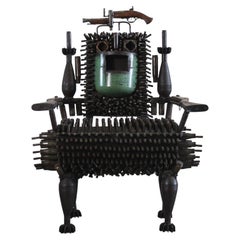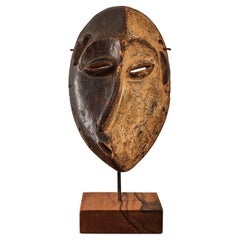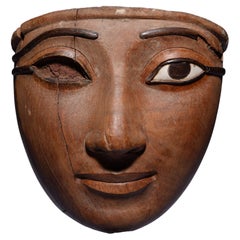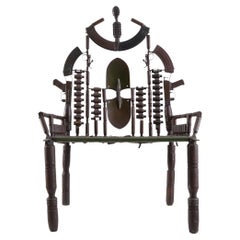Gonçalo Mabunda Furniture
2
to
2
2
2
2
2
2
1
2
2
2
2
5,206
4,014
2,455
2,235
Creator: Gonçalo Mabunda
Gonçalo Mabunda the Extraordinary Talented Throne, 2018
By Gonçalo Mabunda
Located in Montecatini Terme, IT
The extraordinary talented throne (2018), a unique artwork by Gonçalo Mabunda in metal scraps and decommissioned ammunitions.
Mabunda was born in 1975...
Category
2010s Mozambican Other Gonçalo Mabunda Furniture
Materials
Other, Metal
Goncalo Mabunda War, Mask, 2017
By Gonçalo Mabunda
Located in Untersiggenthal, AG
Goncalo Mabunda's wall sculptures are made from decommissed weapons.
His artworks are exhibtited all over the world.
Category
21st Century and Contemporary Mozambican Gonçalo Mabunda Furniture
Materials
Metal
Related Items
Pende Illness Mbangu Mask
Located in Long Island City, NY
Pende Illness Mbangu Mask on a wooden base.
Category
20th Century Gonçalo Mabunda Furniture
Materials
Wood
Exceptional Egyptian Sarcophagus Mask
Located in London, GB
Exceptionally Fine Wooden Sarcophagus Mask
Third Intermediate Period, 21st Dynasty, circa 1069-945 BC.
Acacia wood, rosewood, hippopotamus ivory
Masterfully carved from a single piece of fine-grained hardwood, the present mask is characteristic of the most exquisite funerary art made during the 21st Dynasty, and was probably commissioned for a particularly high-ranking individual.
The oval face displays a gently smiling mouth with full, outlined lips, furrows at the corners and a bow-shaped philtrum. The straight nose with rounded nostrils, the cheeks full and fleshy and the large, almond shaped eyes with heavy lids and tapering cosmetic lines, set below long, sweeping eyebrows.
Social collapse across the Mediterranean in the Late Bronze Age meant that the 21st Dynasty in Egypt was a period of great turmoil. Trade routes were disrupted, governments collapsed, and mass migration occurred. Economic scarcity meant that traditional funerary practices in Egypt were also affected, with a lack of material and financial resources leading to the reuse of preexisting material. As a result, during the 21st Dynasty, 19th and 20th Dynasty coffins changed ownership rapidly and were heavily recycled for new purposes. Tombs were also unmarked allowing them to be shared
by many people. These new practices brought forth a shift in the understanding of funerary paraphernalia. No longer important objects owned forever by the deceased, they were now simply seen as short-term transformative devices, whose symbolic and ritualistic meaning could be appropriated for others. However, paradoxically, the art of coffin-making also reached new heights during this period, and many of the richly dec- orated “yellow” coffins, characteristic of the 21st Dynasty, are remarkable works of art in their own right. Indeed, knowing that coffins were being reused throughout Egypt, the Egyptian élite set themself apart by commissioning lavish sarcophagi decorated with the images and texts meant to help guide them to the afterlife, and which would otherwise have adorned the tomb walls. As coffins were the chief funerary element which now identified the dead and allowed them a physical presence in the world of the living, their quality and appearance were of the utmost importance.
The traditional coffin ensemble was made of three parts: a wooden mummy cover, which laid directly atop the mummy, an inner coffin, and an outer coffin, both made of a lid and case. Additional decorative elements, such as masks, were carved out separately and later glued or pegged to the lids. After the completion of the painted decoration, the sarcophagus was covered in a varnish to give it its yellow colour. Gilding was sometimes used for the coffins of the high priests’ families, notably on parts representing naked skin, such as the face mask. However, some of the élite tactically avoided gilding altogether as to ensure that their coffin would not be looted.
When manufacturing the inner and outer coffins, particular attention was paid to the woodwork. Displaying the skill of the carpenter, this type of funerary art has largely remained unparalleled throughout Egyptian history. The principal wood used to craft the present mask is Acacia nilotica. The evergreen Egyptian acacia was considered sacred and said to be the tree of life, the birthplace of the god Horus, as well as symbolic of Osiris, the god of the dead and resurrection. The modelling of the face in the wood is superb, but the inlays also help mark this mask out as exceptional. Inlaid eyes and eyebrows were extremely rare and reserved to the finest and most expensive coffins. Traditionally, eyes were made of calcite, obsidian, or quartz, and eyebrows of coloured glass paste or bronze. Here, the pupils, eyebrows, and cosmetic lines are inlaid with Dalbergia melanoxylon, a rare type of wood which belongs to the rosewood genus.
In antiquity, however, it was known as Ebony of the Pharaohs, from the Egyptian word “hbny”, meaning dark timber, because of its black, lustrous appearance. An extremely dense and hard wood requiring significant skill to work with, ebony was a luxury material highly coveted by the pharaohs themselves, to make furniture, decorative and funerary objects. The wood was imported with great effort from the southern Land of Punt, most likely modern Sudan, Ethiopia, Djibouti, and Eritrea, alongside other luxury goods such as gold and ivory.
A magnificent ebony throne, recovered in the tomb of King Tutankhamun, illustrates the incredible aesthetic potential of this material and why it was so highly valued by Egyptian royalty. Only élite members of Egyptian society could have afford- ed Ebony of the Pharaoh inlays for their funerary mask.
The sclerae on the present piece were once both inlaid with hippopotamus ivory. Whiter than elephant ivory, this type of ivory is also denser, and more difficult to carve. The use of this luxury material, reputed for its gleaming appearance, enhances the lifelikeness of the eyes. For the Egyptians, hippopotamus ivory was imbued with magic powers. The hippopotamus was indeed both feared and venerated due to its aggressive behaviour. Whilst the male hippopotamus was associated with danger and chaos, the female was benevolent and invoked for protection, especially of the house and
of mothers and their children, through the hippopotamus goddess Tawaret. Thus, not only was hippopotamus ivory used as an inlay and to make practical objects, such as combs and clappers, but it was also used to make talismans like apotropaic wands or knives.
Made during a time of scarcity where few could afford made-to-order coffins, the present mask could have only belonged to one of the highest-ranking individuals in society. Undoubtedly one of the finest Egyptian coffin...
Category
15th Century and Earlier Egyptian Egyptian Antique Gonçalo Mabunda Furniture
Materials
Fruitwood, Hardwood
Mid-Twentieth Century Granary Door Lock in the Form of a Crocodile
Located in London, GB
This mid-twentieth century Bambara door lock from Mali has been carved into the form of a crocodile, a symbol of protection in the Bambara culture. The crocodile-shaped door lock, ad...
Category
Mid-20th Century Malian Tribal Gonçalo Mabunda Furniture
Materials
Hardwood
Three-Legged Tribal Stool Attributed to the Oromo from Ethiopia, Africa
Located in Miami, FL
A three-legged African stool or seat carved from a single piece of wood, attributable to the Oromo people in or around the city of Jimma in Ethiopia. This stool was as a utilitarian ...
Category
20th Century Ethiopian Tribal Gonçalo Mabunda Furniture
Materials
Wood
Art of Africa Treasures from the Congo Hardcover Table Book
Located in North Hollywood, CA
Reference book on the art of the Democratic Republic of Congo (formerly Zaire).
180 mounted color illustrations + numerous b&w illustrations.
large heavy book, weight: 8 lbs
Art of Africa: Treasures from the Congo
Cornet, Joseph
Published by Phaidon Press, Ltd., London (1971...
Category
Late 20th Century Congolese Tribal Gonçalo Mabunda Furniture
Materials
Paper
Yoruba Egungun Headdress Mask
By Yoruba People
Located in Chicago, IL
Attributed to the Yoruba people of western Nigeria, this wooden headdress was worn during a masquerade known as egungun. A widespread Yoruba ritual, egungun performances honor a comm...
Category
Early 20th Century Nigerian Tribal Gonçalo Mabunda Furniture
Materials
Wood
Death Mask
Located in Savannah, GA
A plaster death mask, circa 1880.
5 ¾ inches wide by 3 ¾ inches deep by 8 ½ inches tall
Category
Late 19th Century Unknown Victorian Antique Gonçalo Mabunda Furniture
Materials
Plaster
Laocoonte Mask
By Raffaello Romanelli
Located in Milan, IT
This superb decorative piece rests on a metal pedestal and reproduces in bronze a detail of the marble sculptural group entitled Laocoon and His Sons...
Category
2010s Italian Gonçalo Mabunda Furniture
Materials
Metal, Bronze
20th Century-African, Iron Object Made by the Lobi Tribe of Burkina Faso, Africa
Located in Sammu-shi, Chiba
An iron figurine made in Africa around the 20th century.
In many countries in Africa, iron objects are used for objects, coins, tools, and rituals.
Dogo...
Category
20th Century Burkinabe Tribal Gonçalo Mabunda Furniture
Materials
Iron
H 4.89 in W 13.59 in D 1.74 in
The Art of African Textiles 1997
Located in North Hollywood, CA
The Art Of African Textiles
Clarke, Duncan. Published by Thunder Bay., San Diego., 2002.
This book offers a fascinating journey through the history and culture of textiles in Afric...
Category
Late 20th Century African Tribal Gonçalo Mabunda Furniture
Materials
Paper
From the Rush Limbaugh Collection Korhogo Cloth from Ivory Coast of Africa
By Korhogo Tribe
Located in Asheville, NC
This is a hand spun, hand woven and hand painted cotton cloth for which an entire village takes part in its creation. Women of the Korhoga Tribe spin the cotton, while the men weave ...
Category
19th Century Primitive Antique Gonçalo Mabunda Furniture
Materials
Cotton
H 64.75 in W 101.25 in D 2.5 in
Apollo Belvedere Mask
By Raffaello Romanelli
Located in Milan, IT
A superb addition to a personal collection or a magnificent gift for a lover of antiquity, this mask reproduces in stunning detail the iconography of the Greek god Apollo...
Category
2010s Italian Gonçalo Mabunda Furniture
Materials
Bronze, Iron
Previously Available Items
Goncalo Mabunda War-Throne 2015
By Gonçalo Mabunda
Located in Untersiggenthal, AG
One of the first War- Thrones Goncalo Mabunda made from decommissed weapons.
His artworks are exhibtited all over the world.
Category
21st Century and Contemporary Mozambican Gonçalo Mabunda Furniture
Materials
Metal
Gonçalo Mabunda furniture for sale on 1stDibs.
Gonçalo Mabunda furniture are available for sale on 1stDibs. These distinctive items are frequently made of metal and are designed with extraordinary care. There are many options to choose from in our collection of Gonçalo Mabunda furniture, although black editions of this piece are particularly popular. Prices for Gonçalo Mabunda furniture can differ depending upon size, time period and other attributes — on 1stDibs, these items begin at $10,882 and can go as high as $23,567, while a piece like these, on average, fetch $20,025.




